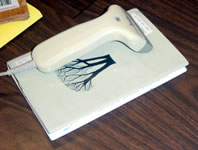The teacher librarian must maintain an accurate inventory of all items associated with the library media program including hardware, software, and furnishings. In some cases this includes holdings in other areas of the school building such as televisions and computers.
 I've heard about school libraries that have been destroyed by tornado, fire, or flood. How would we rebuild after a disaster?
I've heard about school libraries that have been destroyed by tornado, fire, or flood. How would we rebuild after a disaster?
Last night someone broke the window in the library and stole eight of our computers including our circulation system. What do we do?
It seems like other high schol libraries have many more resources than we do. How do I justify additional materials, computers, and other resources?
The situations above are troubling, but realistic. A contingency plan, along with a comprehensive inventory are essential when facing a wide range of potential concerns from natural disasters to external audits.
What is inventory?
Computers, books, tables, chairs, globes, overhead projectors, and stuffed toys are just a few of the items in your school library media center. Each of these items is listed in your inventory. An inventory is an accounting of each of these items. In many cases, the media specialist is in charge of the inventory of equipment in the entire building including everything from copies to computer printers.
The word inventory is also used to describe a process by which items and information in the holdings record are verified and the physical condition of each item is assessed.
It's possible to generate an "inventory" report from most automated circulation systems, however this is not a complete view of what is actually in the building. An inventory for the purposes of accounting requires that someone physically account for each item.
Theoretically, this means examining every book, computer, and videotape in your collection. Practically, this is unrealistic. A compromise would provide the required data for decision making, yet still maintain the sanity of the library professional.
What is the purpose of inventory?
An inventory has many purposes. For example, let's say you're writing a grant and want to recommend additional computers in the library. Use your inventory to provide data about the numbers, types, and ages of computers to justify purchases.
Inventory is used for the following purposes:
- assist in collection development and facilities planning
- identify items that should be repaired, replaced, or removed
- identify loss
- have records for emergencies
- have records for budget justification
- make more effective use of facilities as a whole
What should be inventoried?
The items on an inventory vary from school to school. In general, the library media specialist maintains an inventory of the library's collection including items such as books, videos, audios, kits, maps, etc.
The media specialist may also be in charge of the equipment in the center as well as the building. For example, you may be in charge of checking the location of all computer equipment, television monitors, VCRs, and overhead projectors in the building.
Some schools require an accounting of all furnishing such as desks, tables, and chairs.
What is involved with conducting inventory?
Before the time of automated library systems, library media specialists did the inventory by hand. This meant matching each item to a master shelf list card. Missing books were indicated on the card.
Times have changed. Today, technology is used to facilitate the inventory process. Many teacher librarians now use digital camera or video cameras to record a quick view of the different areas of the library. They also use an automated library system to speed up inventory.
Inventory involves the following ten elements:
- most commonly at the end of the school year
- scheduled when the center is not busy, when school is closed
- arrange materials in the correct order
- develop a strategy for moving through the collection
- remove items that need to be purged or repaired
- check are for missing items
- prepare inventory report
When should inventory be conducted?
Most schools require an inventory once per year. Although some people view inventory as something that is done at the end of the school year, there are other options. In some case, the school administration has particular needs. In districts with multiple buildings, inventory is sometimes rotated among buildings. Some schools have never had a detailed inventory conducted.
It is recommended that you conduct inventory once per year to identify lost materials and get materials into their proper place.
Check Your Understanding
![]() Information
Power - Information Access and Delivery: Principle 2.
Information
Power - Information Access and Delivery: Principle 2.
The library media
program provides physical access to information and resources for learning.
(p. 83, 86)
In order for you to provide good access to materials, you need to know their location. Conducting an inventory can be overwhelming. Where would you start? Would you do it alone or get help? Develop a plan for conducting an inventory.
Make It Real
 Interview a teacher librarian about their experiences with conducting inventory. Be sure to ask about what items are inventoried, what records are maintained, and how the library automation system works.
Interview a teacher librarian about their experiences with conducting inventory. Be sure to ask about what items are inventoried, what records are maintained, and how the library automation system works.
Are they responsible for items throughout the building or just in the library media center?
Ask them to share their concerns, frustrations, and experiences.